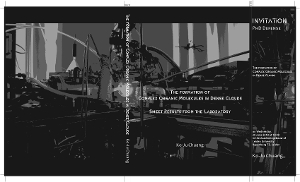Proefschrift
The formation of complex organic molecules in dense clouds-Sweet results from laboratory
Large areas of space are filled by molecular clouds that consist of gas and dust grains that are the remnants of dead stars. When these clouds start collapsing, the decreasing temperature and increasing density cause gas particles to start accreting onto dust grain surfaces.
- Auteur
- Chuang, K.
- Datum
- 20 juni 2018
- Links
- Thesis in Leiden Repository

Large areas of space are filled by molecular clouds that consist of gas and dust grains that are the remnants of dead stars. When these clouds start collapsing, the decreasing temperature and increasing density cause gas particles to start accreting onto dust grain surfaces. This results in layered geometries of partially mixed ices on top of the grains that act as molecule reservoirs and cryogenic catalysts on which both simple and complex molecules form in surface reactions. These grains form the material from which celestial bodies form. A good understanding of the elementary processes taking place in dark interstellar clouds, therefore, is necessary to understand the chemical inventory of stellar systems, like our own Solar system.This thesis focuses on laboratory studies investigating the surface chemistry of CO-rich ices on dust grains at temperatures as low as 10 K. The formation mechanisms of complex organic molecules (COMs) are investigated by non-energetic processes (e.g., hydrogenation) and energetic processes (e.g., photolysis). Moreover, the net transfer of the newly formed hydrogenated species from grain surfaces into the gas phase through non-thermal desorption is investigated to link the detection of COMs in the gas phase to their formation in the solid state.
